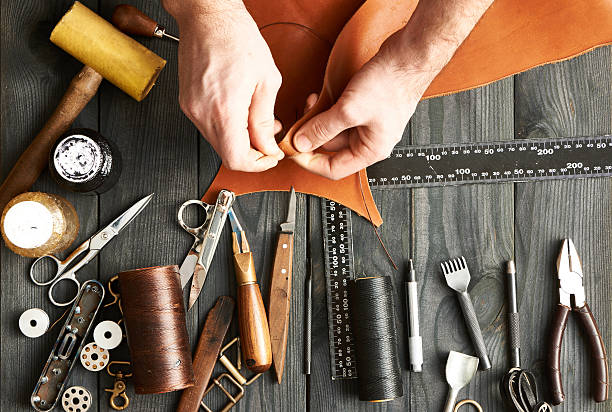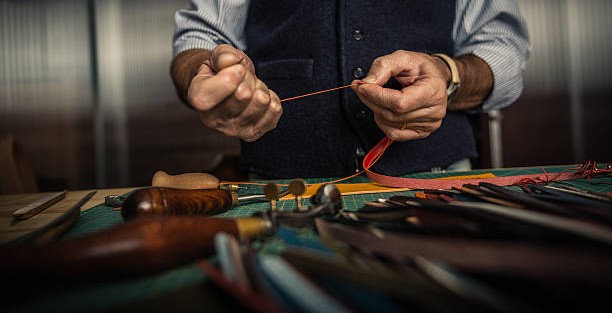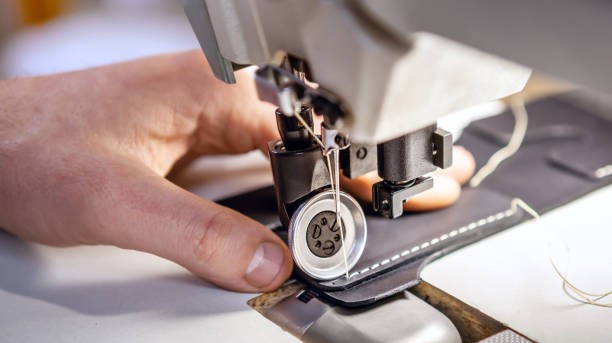
Blog
Introduction to Leather Tools

In the leather industry, a variety of tools are used for cutting, stitching, and finishing leather products. These tools help artisans and manufacturers create high-quality and precise items. Here’s an overview of some essential leather tools:
1. Awl :
Description: An awl is a pointed tool used in leatherworking to create holes in leather. It is an essential tool for preparing the leather for stitching.
Purpose :
– Hole Creation: The awl is primarily used to make evenly spaced holes in leather, which is crucial for accurate stitching.
– Marking: It can also be used to mark the location of holes before cutting, ensuring precision in the stitching process.
Types of Awls :
1. Standard Awl: A simple, straight awl with a sharp point, ideal for general hole-making.
2. Diamond Awl: Features a diamond-shaped point that creates larger holes, allowing for easier stitching, especially with thicker threads.
3. Pricking Awl: Used for making precise holes that are evenly spaced, often utilized in conjunction with a stitching guide.
Usage Tips :
– Angle: Hold the awl at a slight angle to create a clean hole and avoid damaging the leather.
– Pressure: Apply consistent pressure while pushing the awl through the leather to ensure smooth hole creation.
– Maintenance: Keep the awl clean and sharp for optimal performance.

2. Leather Knife :
Description: A leather knife is a specialized cutting tool designed for accurately cutting leather. It typically features a sharp blade and an ergonomic handle for ease of use.
Purpose :
– Cutting: The primary function of a leather knife is to make clean and precise cuts in leather, whether for straight lines or intricate shapes.
– Trimming: It is also used for trimming excess leather and creating smooth edges on finished pieces.
Types of Leather Knives :
1. Fixed Blade Knife: A sturdy knife with a non-folding blade, ideal for heavy-duty cutting tasks.
2. Folding Knife: A portable option with a blade that folds into the handle, making it convenient for carrying.
3. Rotary Cutter: A circular blade tool that is useful for cutting straight lines quickly, especially in larger pieces of leather.
Usage Tips :
– Cutting Surface: Always use a cutting mat or board to protect the blade and maintain sharpness.
– Blade Angle: Keep the blade at a consistent angle while cutting to ensure clean lines.
– Safety: Use caution while handling the knife, and always cut away from your body.
3. Stitching Pony :
Description: A stitching pony is a clamp used to securely hold leather pieces in place while stitching. It provides stability and allows artisans to work more efficiently.
Purpose :
– Stability: Keeps leather pieces firmly in place, preventing them from shifting during the stitching process.
– Hands-Free Operation: Frees up both hands for more precise stitching, improving accuracy and control.
Types of Stitching Ponies :
1. Basic Stitching Pony: A simple, adjustable clamp that can hold various thicknesses of leather.
2. Adjustable Stitching Pony: Features a mechanism to easily adjust the height and grip, accommodating different types of projects.
3. Portable Stitching Pony: Lightweight and foldable, ideal for on-the-go leatherwork.
Usage Tips :
– Adjust Tension: Ensure the leather is held firmly but not overly tight to avoid damaging the material.
– Positioning: Place the stitching pony at a comfortable height to reduce strain while working.
– Secure Setup: Make sure the pony is stable on your work surface to prevent movement during stitching.
4. Edge Tools :
Description: Edge tools are specialized instruments used to finish and shape the edges of leather pieces. They help achieve a polished and professional look.
Purpose :
– Smoothing: Edge tools are used to smooth out rough edges, preventing fraying and giving a clean finish.
– Beveling: They can create a beveled edge, which adds an aesthetic appeal and enhances the durability of the leather.
– Burnishing: Tools like burnishers are used to round and polish the edges, providing a finished appearance.
Types of Edge Tools :
1. Edge Beveler: A tool with a curved blade that trims the edge of the leather at an angle, creating a beveled effect.
2. Burnisher: A rounded tool, often made of wood or plastic, that smooths and polishes the edges through friction.
3. Edge Trimmer: A tool designed to cut the edges of leather to a uniform width, ensuring consistency across pieces.
Usage Tips :
– Technique: Use consistent pressure when beveling or burnishing to achieve an even finish.
– Moistening: Lightly dampen the edges before burnishing to help achieve a smoother result.
– Practice: Experiment with different angles and techniques to find the best method for your specific project.

5. Leather Needle :
Description: Leather needles are specially designed sewing needles with a sharp point and a larger eye to accommodate thicker threads. They are essential for both hand and machine stitching in leatherwork.
Purpose :
– Stitching: Specifically designed for piercing through multiple layers of leather without damaging the material.
– Thread Compatibility: The larger eye allows for thicker threads, which are often used in leather projects for added strength.
Types of Leather Needles :
1. Hand Sewing Needles: These needles come in various sizes and are used for hand-stitched projects.
2. Machine Needles: Designed for sewing machines, these needles are made to handle the thickness and density of leather.
3. Chisel Needles: These have multiple points and are used for creating evenly spaced holes for saddle stitching.
Usage Tips :
– Needle Size: Choose a needle size appropriate for the thickness of the leather and the type of thread being used.
– Threading: Ensure the thread fits comfortably through the needle’s eye to avoid fraying or breaking.
– Maintenance: Regularly check for bent or dull needles, as they can damage the leather and affect stitching quality.

6. Leather Adhesive :
Description: Leather adhesive refers to various types of glues specifically formulated for bonding leather pieces together. These adhesives are essential for securing joints before stitching or for projects that do not require stitching.
Purpose :
– Bonding: Provides a strong, flexible bond between leather pieces, enhancing structural integrity.
– Pre-Stitching Aid: Holds pieces in place before sewing, ensuring accurate alignment and preventing movement during stitching.
– Finishing Touch: Can be used for attaching embellishments or lining materials to leather products.
Types of Leather Adhesives :
1. Contact Cement: A strong, flexible adhesive that bonds on contact. It’s ideal for large surfaces and provides immediate hold.
2. Water-Based Adhesive: A safer, less toxic option that’s easier to clean up. Suitable for lightweight applications.
3. Hot Glue: Useful for quick fixes and temporary holds, though not as durable as other options for long-term use.
Usage Tips:
– Surface Preparation: Ensure surfaces are clean and dry before applying adhesive for the best bond.
– Application: Apply a thin, even layer of adhesive to both surfaces for optimal adhesion, then press them together firmly.
– Drying Time: Allow adequate drying time as specified by the manufacturer for the best results.

7. Stamps and Molds :
Description: Stamps and molds are tools used to create decorative patterns and designs on leather. They play a significant role in enhancing the aesthetic appeal of leather products.
Purpose :
– Decoration: Add unique designs, textures, and details to leather items, making them visually appealing.
– Customization: Allow artisans to personalize their products with initials, logos, or specific patterns.
– Consistent Patterns: Enable the reproduction of the same design across multiple items for uniformity in production.
Types of Stamps and Molds :
1. Decorative Stamps: These come in various shapes and designs, such as floral patterns, geometric shapes, or custom logos.
2. Lettering Stamps: Used for imprinting letters and numbers, great for personalization.
3. Molds: Shaped forms that can be used to create three-dimensional designs or textures on leather.
Usage Tips :
– Preparation: Ensure the leather is clean and slightly damp for better imprinting.
– Pressure: Apply even pressure when stamping to achieve a clear and consistent design.
– Experimentation: Practice on scrap pieces of leather to find the right technique and pressure for desired effects.

8. Sewing Wheel :
Description: A sewing wheel, also known as a tracing wheel, is a tool used in leatherworking to mark stitching lines and create accurate patterns. It features a series of sharp, evenly spaced teeth that leave an impression on the leather.
Purpose :
– Marking: Helps create precise stitching lines, ensuring consistent spacing and alignment in sewing.
– Pattern Creation: Useful for transferring patterns from paper templates to leather, making it easier to cut and stitch accurately.
– Guiding: Acts as a guide for stitching, helping artisans follow lines more easily.
Types of Sewing Wheels :
1. Standard Sewing Wheel: Features a single row of teeth for basic marking tasks.
2. Dual-Wheel Sewing Wheel: Equipped with two rows of teeth, allowing for different spacing options in marking.
3. Adjustable Wheel: Allows the user to change the distance between the teeth for various stitching requirements.
Usage Tips :
– Surface: Use on a cutting mat or a sturdy surface to avoid damaging the tool and ensure clean lines.
– Pressure: Apply consistent pressure while rolling the wheel to create clear, visible marks.
– Practice: Experiment with different spacing and techniques on scrap leather to find the best method for your projects.


